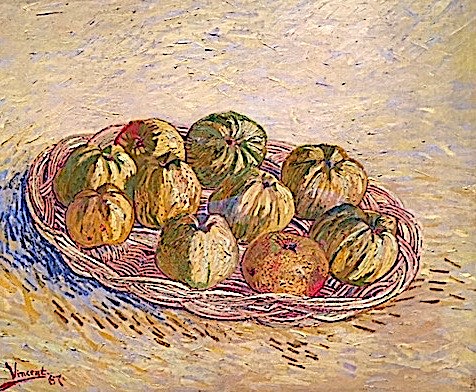
❖❖❖
IN THIS ISSUE
THE PRESENT STATE OF
DINING OUT IN CALIFORNIA:
An Interview with Piero Selvaggio
By John Mariani
NEW YORK CORNER
PEKARNA
By John Mariani
CAPONE'S GOLD
Chapter 25
By John Mariani
NOTES FROM THE WINE CELLAR
THE WINES OF ALSACE
By Geoff Kalish
❖❖❖

On this week's episode of my WVOX Radio Show "Almost Golden,"
.jpg) on
Wed. Sept. 22 at 11AM EDT I
will be interviewing film historian Manny
Pacheco on the Ten Best Hollywood Movies
of the 1950s. Prepare for fireworks!Go
to: WVOX.com.
The episode will also be archived at: almostgolden.
on
Wed. Sept. 22 at 11AM EDT I
will be interviewing film historian Manny
Pacheco on the Ten Best Hollywood Movies
of the 1950s. Prepare for fireworks!Go
to: WVOX.com.
The episode will also be archived at: almostgolden.❖❖❖
THE PRESENT STATE OF
DINING OUT IN CALIFORNIA:
An Interview with Piero Selvaggio
By John Mariani
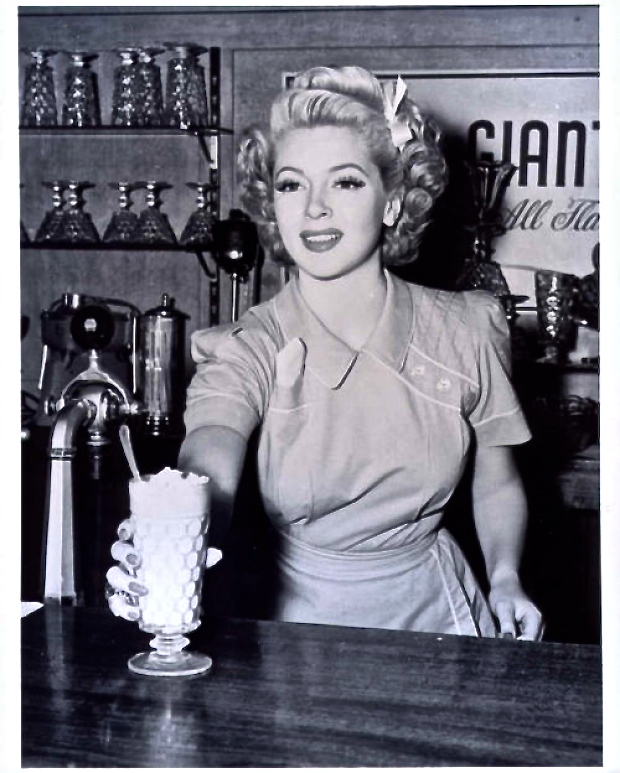
Lana Turner at Schwab's
Back
in the 1970s Los Angeles and San Francisco led a
revolution in American cuisine at restaurants
like Chez Panisse in Berkeley and Spago in L.A.
New access to ingredients, an import of great
chefs and restaurateurs and an increasingly
sophisticated dining public that fed as much on
the food and wine as the glamor made the state a
beacon of great restaurants and innovative
style. There at the start was Piero Selvaggio (below),
a Sicilian immigrant, who transformed Italian
restaurants from the mundane to the sublime at
his Valentino in Santa Monica, whose influence
was worldwide on the image of Italian cuisine
and wine. Then,
after decades of culinary fads and fancies and
the onslaught of Covid, Valentino closed its
doors, and now Selvaggio works at the fine Drago
restaurant. I interviewed him about all the
changes he’s seen since Covid hit the state.
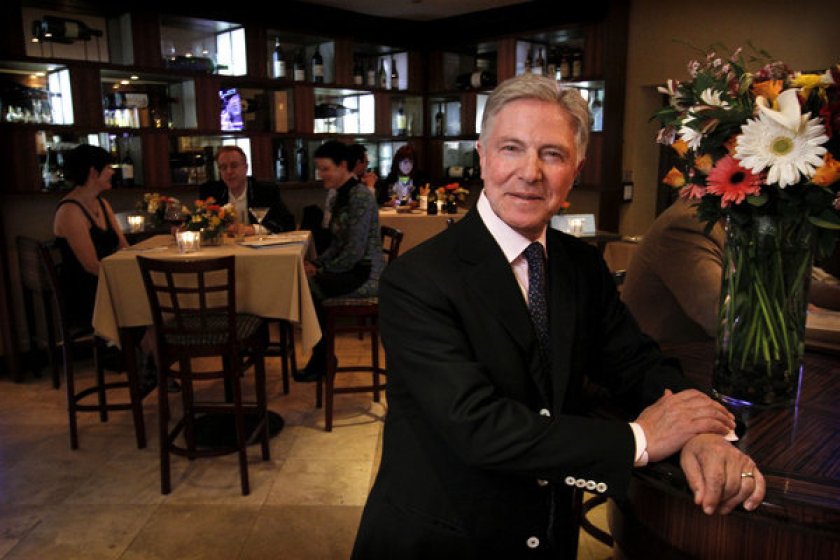 How has the pandemic
affected dining out in Southern California?
How has the pandemic
affected dining out in Southern California?
The pandemic
has had a big impact in the world’s business and
on people’s habits So, California,
like New York, has been more affected than other
states and big cities, mostly, because of
the restrictions of the lawmakers and their
leadership. Business overall is good at
dinner. People are Covid-fatigued and want
to go out, repeat the old habits, entertain
friends, celebrate outside of home confinement.
So, the good restaurants, based on locations, are
doing good business, and some more than before,
due to more limited choices for the
consumer.
The ones who are suffering are restaurants
in business districts, where buildings are almost
empty, and
lunch business has disappeared.
Have there been many
closures?
Yes, many places closed
for good, many are heavily indebted and have
downscaled, leaning more on to-go and deliveries.
What innovations have
restaurateurs been making to keep going?
For many, the P P Loans
and the various state protections weren’t enough
to help stay afloat and busy, So Zoom, as in
other businesses, became their forum: Regional
dinners, buy the ingredients and we'll guide you
cooking them, virtual wine tasting with food
matching, themes for regional or eclectic
cooking. And then chefs cooking for groups
at private homes, discounts, Social
communications. The changes are based on age
groups: The older either stay home and have
deliveries, or must dine
outside, on patio or sidewalks, for fear.
Most instead, can't wait to take off masks
and dive into old dining habits. Once seated, it
is forgotten, masks and all.
Are people coming back
to fine dining?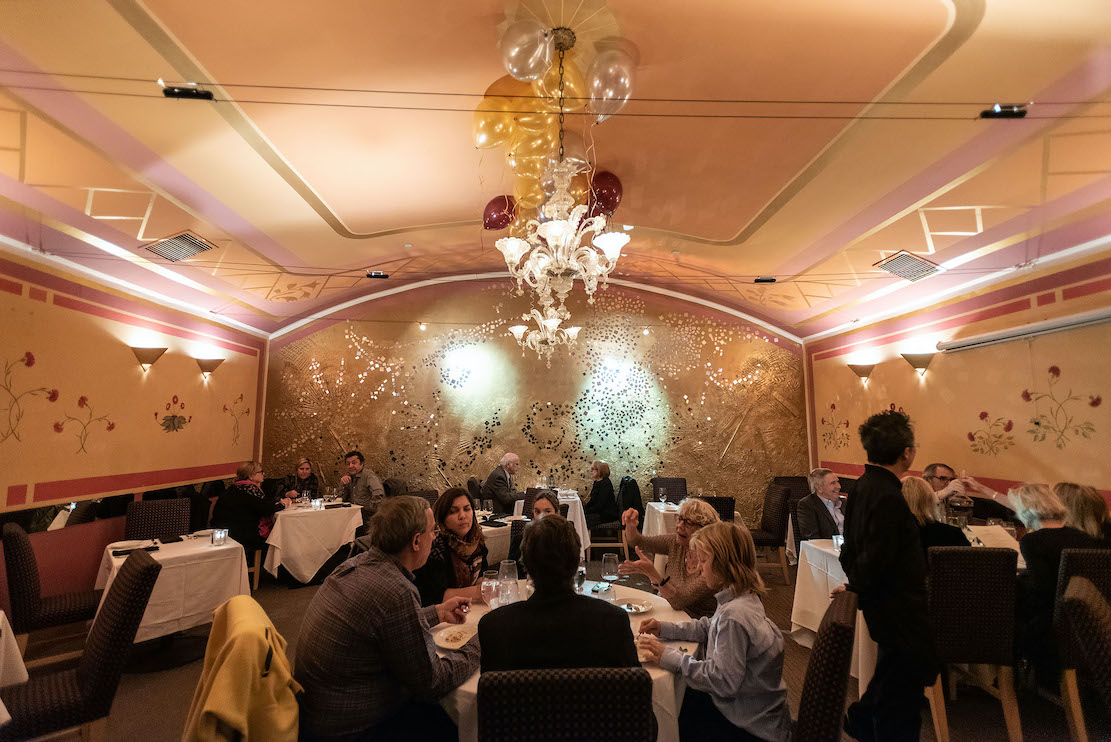
Dining has never been
more casual than now. Yes, to jewelry, expensive
watches and shoes, but flip flops are now
accepted, dogs are sometimes part of the group,
and it is hard to judge people’s taste and wealth
from their dress code. Besides, the music and film
industry, just as do the rich millennials, have
never taken dressing up
seriously. Today dining doesn't include
the word "fine." The proliferation of Mexican
and ethnic restaurants, little support of the
press, confusion of what to expect, have all been
factors in driving a lot of drinking—mezcal,
tequila, shots—more hard liquor than wine with
food. All reasons to accept this new form of
eating in restaurants.
Valentino, Santa Monica
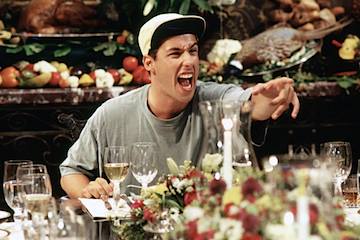 Have
prices risen?
Have
prices risen?
Prices are generically
accepted. Cost of living, labor, fixed cost are so
high overall, and it is a given, that a Prime
steak or meat is now above $60, and for the
few snobs it can go to a thousand
as at Salt Bae, where you are made aware that it
is another period of temporary fads for the
ultra-rich, who seem to love gold in their food.
How is Italian food
doing in the U.S.?
Italian food at the top
is extremely popular, but mostly there are no
high-end Italian restaurants any
more. Today, every restaurant in
America has products like burrata, buffalo
mozzarella, truffles, homemade pasta, designer
pizza and Brunellos on the wine list. It was
our contribution—Mauro Vincenti, Tony May, Lidia
Bastianich, Marcella Hazan—who brought Italian
food to where it is in America today. We
paved the road for the success of Eataly today and
for all of the fine products that you find in good
markets.
How are things going
in Italy itself?
The emerging chefs also
in Italy are adopting, influenced by techniques of
other cuisines, a lot of inspiration from the 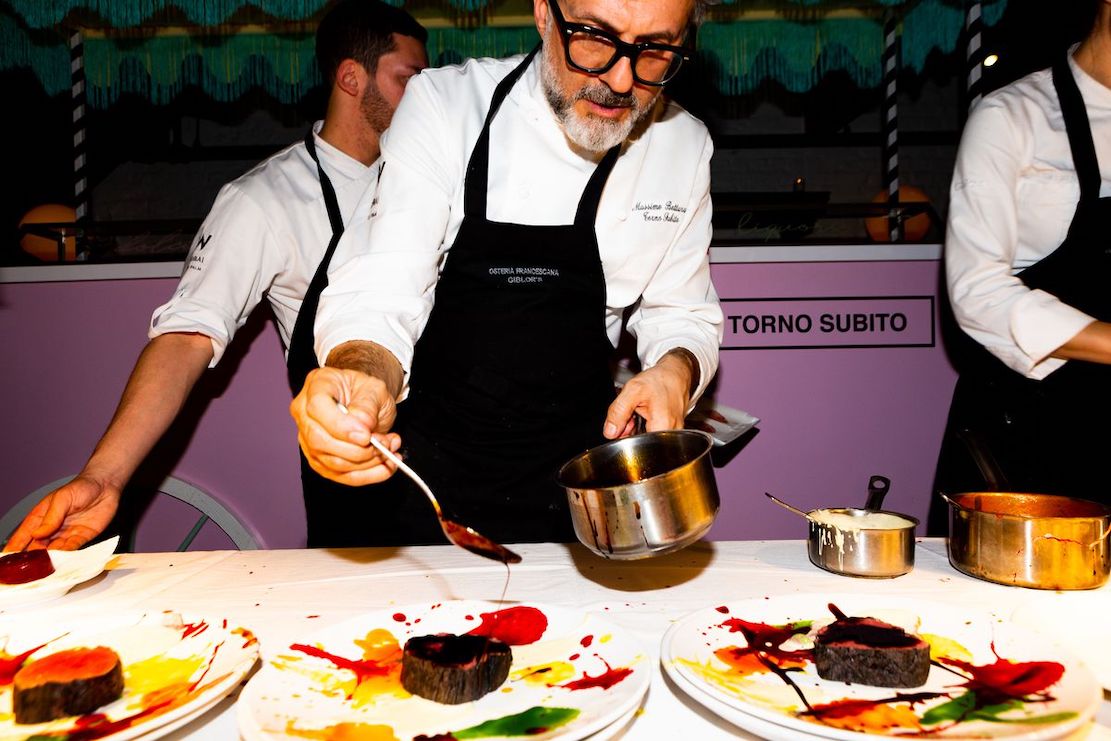 Japanese
discipline of process and presentation.
Otherwise, there is a revisiting of old Italian
and regional dishes reinterpreted or adapted to
today’s diets and fantasy, like the cooking of
Massimo Bottura (right), Max Alajmo and
Pino Cuttaia, as well as steady traditionals like
Nadia Santini at Dal Pescatore,. Artisans
are still relevant and now more appreciated along
with the collaboration of purveyors, farmers and
chefs.
Japanese
discipline of process and presentation.
Otherwise, there is a revisiting of old Italian
and regional dishes reinterpreted or adapted to
today’s diets and fantasy, like the cooking of
Massimo Bottura (right), Max Alajmo and
Pino Cuttaia, as well as steady traditionals like
Nadia Santini at Dal Pescatore,. Artisans
are still relevant and now more appreciated along
with the collaboration of purveyors, farmers and
chefs.
Has there been a loss
of sophistication among diners?
The down sliding level of
sophistication in America is a fact of the
times. Technology has had a great impact
and the last year has hit
reality: People have adjusted to eating on
sidewalks, re-warmed food delivered after one
hour, popularization of practical food and finger
food. Fine dining restaurants and business
entertainment and special occasions are not as
popular at the top. Today, the word “restaurant” could
mean anything.
What do see happening
in the future?
The future will mean
adaptations: to prices for quality, less
expectation of service (one of the biggest problem
of today!) and experiences with
various food.
I don't think that Italian food will go
farther than it has because there is now a lack of
talents, lack of labor force, too many imitations
of inferior products (oil, balsamic vinegar,
tomatoes, cheeses, salumi), and these are all
consumer issues for people
that have discovered Italy and its treasures
among those who know the difference. So, today
restaurants will be more continental than before,
incorporating the traveling inspirations, staging
and culinary learnings and interpretations
of the cooking gurus. Besides,
I see a pure talent like my former chef Luciano
Pellegrini opening a pizzeria in Las Vegas and
accepting the commercial aspect and the
name: Heavenly Pies. But we represent a rich
cultural depth of what Italian food is, and as
long as the products are genuine and well
explained and tasted, there will be other young
talents in the kitchen and in the press.
❖❖❖
PEKARNA
954 Amsterdam Avenue646-974-9070
By John Mariani
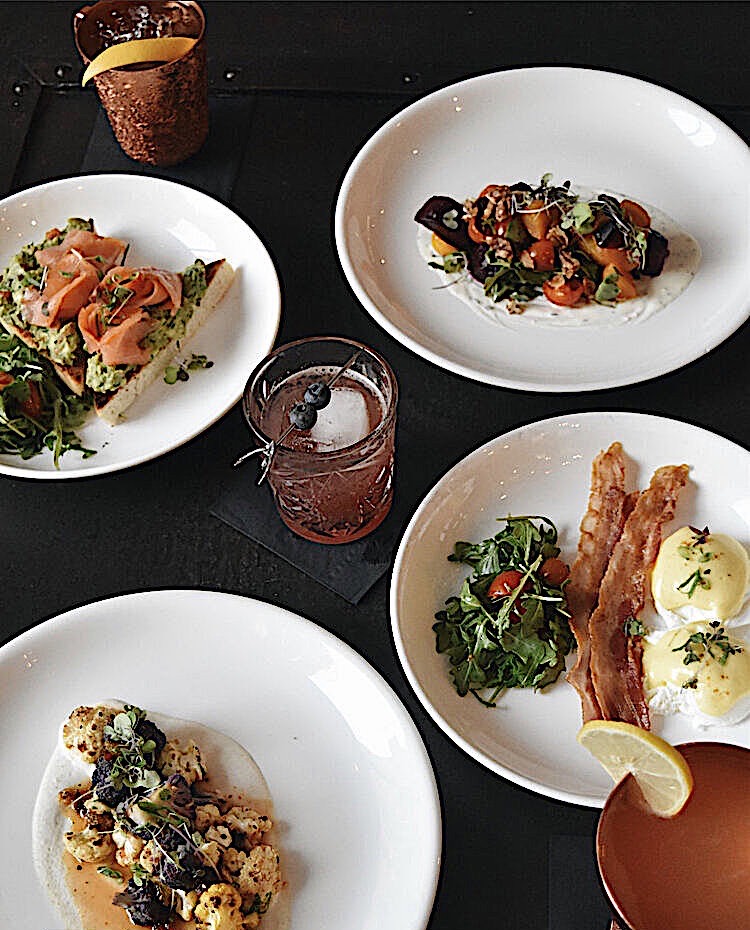
Pekárna is a Serbo-Croatian
word for “bakery,” so it’s a little puzzling as
to why Dean O’Neill (an avionics expert by
trade) gave his delightful new restaurant on the
Upper West Side the name when he describes the
place as a “New American”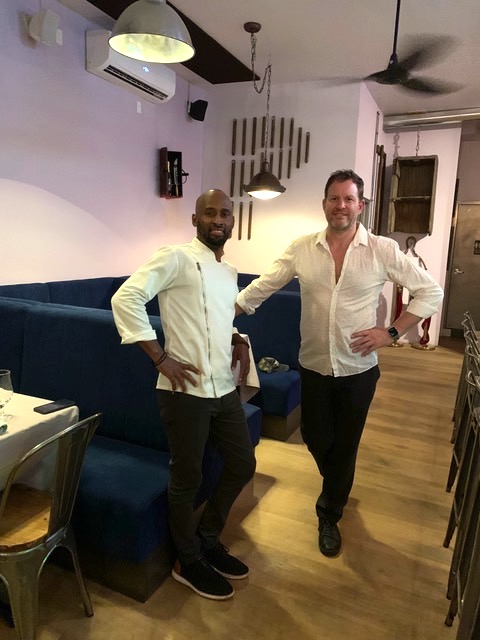 restaurant, cocktail and event venue. There’s no
longer a bakery on the premises, but there are
several Slovenian dishes to make Pekarna New
York unique from most any restaurant in the
neighborhood. Which is even odder since O’Neill
(right) is from Australia and Chef Kamal
Hoyte (right) formerly at Ocean and
Daniel, from the Caribbean island of St.
Vincent. For some reason, it also clicks.
restaurant, cocktail and event venue. There’s no
longer a bakery on the premises, but there are
several Slovenian dishes to make Pekarna New
York unique from most any restaurant in the
neighborhood. Which is even odder since O’Neill
(right) is from Australia and Chef Kamal
Hoyte (right) formerly at Ocean and
Daniel, from the Caribbean island of St.
Vincent. For some reason, it also clicks.
 The
enterprise reminds me, then, of the episode in Seinfeld
when Jerry undertakes to advise Pakistani
restaurateur Babhu Bhat (left) to stop
serving everything from lasagna to roast turkey on
his menu and to concentrate on Pakistani food. Of
course, it turns out to be a disaster because back
in 1991 no one was interested in Pakistani food. I
suspect it would very be different today, so I
urge O’Neill to add more and more dishes from
Slovenia, with whose food he fell in love. Indeed,
he had hoped for an acclaimed Slovenian chef to
come aboard at the beginning, but Covid put the
kibosh on that idea for the present.
The
enterprise reminds me, then, of the episode in Seinfeld
when Jerry undertakes to advise Pakistani
restaurateur Babhu Bhat (left) to stop
serving everything from lasagna to roast turkey on
his menu and to concentrate on Pakistani food. Of
course, it turns out to be a disaster because back
in 1991 no one was interested in Pakistani food. I
suspect it would very be different today, so I
urge O’Neill to add more and more dishes from
Slovenia, with whose food he fell in love. Indeed,
he had hoped for an acclaimed Slovenian chef to
come aboard at the beginning, but Covid put the
kibosh on that idea for the present.
 That
said, I was as happy with the non-Slovenian dishes
as with those that are, not least a really
excellent pumped-up burger of wagyu beef, Swiss cheese, lettuce, tomato,
house-brined cucumber, pickled onions and BBQ
sauce on a toasted Kaiser bun topped with a fried
onion ring. The appetizer portion of French fries
with various dipping sauces is irresistible and
definitely worth ordering for the table.
That
said, I was as happy with the non-Slovenian dishes
as with those that are, not least a really
excellent pumped-up burger of wagyu beef, Swiss cheese, lettuce, tomato,
house-brined cucumber, pickled onions and BBQ
sauce on a toasted Kaiser bun topped with a fried
onion ring. The appetizer portion of French fries
with various dipping sauces is irresistible and
definitely worth ordering for the table.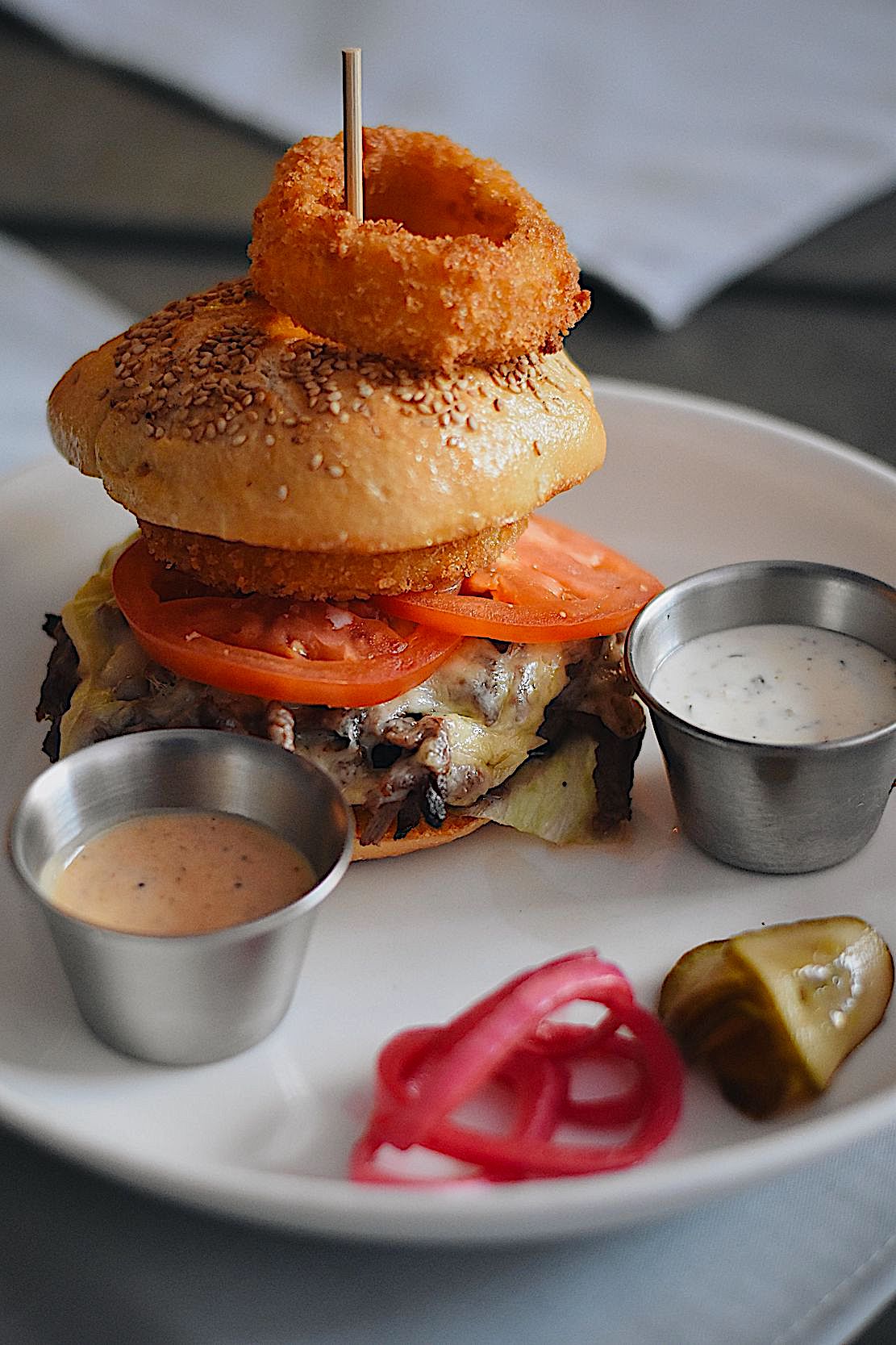
The two rooms are composed of a bar with
tables and a dining section, set with Bosnian
furniture and vintage glass chandeliers. There are
four different event spaces downstairs, with the
Dragon room featuring a Perrier-Jouët Champagne
Bar.
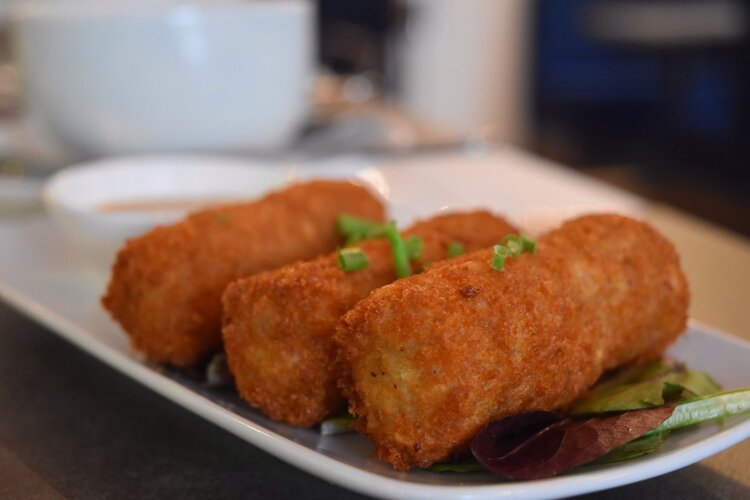 I
asked Chef Hoyte to focus on the Slovenian dishes,
so we began with chicken croquettes (left)
with onion in a rich, flavorful chicken broth
($8). Others included lamb meatballs with a red
sauce of tomato and spices ($16) and crispy wild
boar with rice, mustard and sweet chili sauce
($16), and the spices and seasoning evoke their
Slovenian provenance. Žepki
are fat Slovenian pastries ($7-$8) like pierogi,
typical of Eastern European pastries and always
heartwarming. There are four slider options of
wagyu beef, chicken, mushrooms and salmon ($6-$7),
and colorful linguine with cracked pepper,
artichoke, asparagus,
I
asked Chef Hoyte to focus on the Slovenian dishes,
so we began with chicken croquettes (left)
with onion in a rich, flavorful chicken broth
($8). Others included lamb meatballs with a red
sauce of tomato and spices ($16) and crispy wild
boar with rice, mustard and sweet chili sauce
($16), and the spices and seasoning evoke their
Slovenian provenance. Žepki
are fat Slovenian pastries ($7-$8) like pierogi,
typical of Eastern European pastries and always
heartwarming. There are four slider options of
wagyu beef, chicken, mushrooms and salmon ($6-$7),
and colorful linguine with cracked pepper,
artichoke, asparagus, 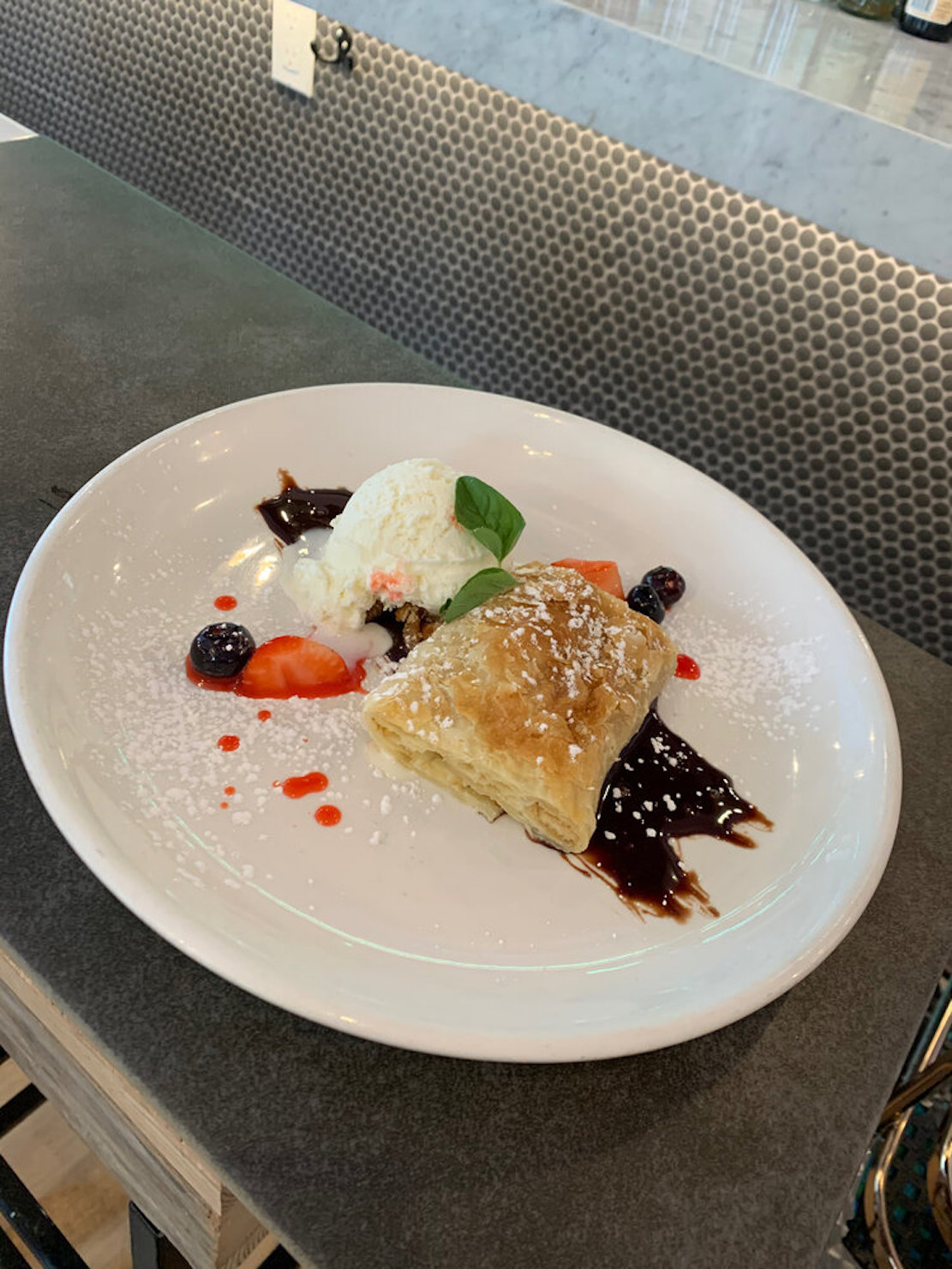 cherry
tomatoes, honey, Parmesan cheese and a spritz of
lemon juice tossed at the table ($22), a
light dish with both tang and the sweetness of
early autumn.
cherry
tomatoes, honey, Parmesan cheese and a spritz of
lemon juice tossed at the table ($22), a
light dish with both tang and the sweetness of
early autumn.
Among several
delectable entrees, the best is the
Slovenian-style herb crusted rack of lamb with a
light potato soufflé, roasted Brussels sprouts, a
carrot cream and a rich, dark reduction of Slovenian
red wine ($32).
Many cultures have their version of fried
chicken, and here it’s done “Island style,” with a
dash of Kamal’s spicy Cajun breading, milk, more
hot sauce, chicken and garlic potato mash and
served as a thigh ($5) or breast
($7).
Desserts run expensive ($12-$16) but large
enough to share, so, for sure, order the Slovenian
apple pie with vanilla gelato, or the Kremšnita
custard cake with a passion fruit glaze.
Kudos
for Pekarna in listing several impressive
Slovenian wines now in the market, including
Sauvignon Blanc 2018; Brutus
2016, Primorje Brda; and Marjan Simčic
̌“Selecija” Pinot Noir Goriska Brda.
So, while
Pekarna is a good balance of American, Caribbean
and Slovenian food cultures, I suspect that a lot
of prospective clientele will be most interested
in the last. But by all means order the French
fries.
Open daily for dinner;
Sat. & Sun. for brunch.
CAPONE’S GOLD
 David
did not think he should make it a habit of
staying at Katie’s apartment, so he decided to
drive home that night and told her to come up
to his place, where he had his old files
stored.
David
did not think he should make it a habit of
staying at Katie’s apartment, so he decided to
drive home that night and told her to come up
to his place, where he had his old files
stored.
“You’re looking particularly pretty
today,” David said when Katie arrived the next
morning, wearing jeans and a yellow turtleneck.
“I got one-and-a-half night’s sleep,” she
said, “on the train and at home. I feel . . .
great. Actually,
odd as it seems, I feel re-energized for our
project. Just narrowing things down, rather than
expanding them.”
“I know how you feel,” he replied,
laughing. “Even though we’ve got bubkis,
we’ve kind of cleared away some dead leaves. Everything
is still somehow disconnected, but the heart of
the matter is coming into better focus. And now
that we’ve eliminated Germany as possible hiding
places, I think we should focus on Italy. I have
some material on the mobs’ activities over there
in the 1930s and ‘40s.”
“So,” Katie said, rubbing her hands
together. “What’ve you got? I hope we have to go
there.”
“What I have and what I remember is
mainly about the Gambino and Genovese crime
families, not about Capone. But
maybe we can—what do they call it?—‘triangulate’
to get to Big Al.”
“Sounds like fun.”
“Okay, so here’s what I know.”
The
three main mobs in Italy, all of them in the
South, kept largely separate from each other in
the early part of the 20th century. The least
known outside of Italy was ‘Ndrangheta, which
controlled crime in Calabria, south of Campania,
where the Camorra ruled, and north of Sicily,
where it was all Mafia.
‘Ndrangheta
was just as powerful as the others but stayed
almost entirely within Calabria, where its
various branches waged occasional battles with
each other. It wasn’t until the mid-seventies
that ‘Ndrangheta started to expand into northern
Italy, Mexico, and a little bit in upstate New
York. They were even responsible for the
kidnapping of John Paul Getty III in 1973; they
cut his ear off as proof of life.
“Anyway,” said David, “I don’t think we
have to pay any attention to them within the
time frame we’re studying.”
“So what about the Camorra, out of
Naples?”
Initiation rite to join the Camorra.
“Well, it
certainly makes sense that, if Capone was going
to get in business with anyone in Italy in the
1930s, it should have been the Camorra. They
were paisans; Capone’s family was from the
region. So,
even though Capone made a big deal about his
being American, not Italian—you know, all his
aliases were WASP names, like ‘Al Brown’—if it
meant he needed an ally in Italy, it should have
been the Camorra.”
The
problem, however, with the Camorra, as David
perceived it, was that, unlike the Mafia and
‘Ndrangheta, it had no single capo at the top;
it was more like a terrorist group, with many
clans, so you had to know which one to deal
with. Also,
the Camorra didn’t have much of a presence in
the U.S. in the ’30s, a few members here, a guy
there who, like Capone, just melded in with the
reigning Italian mob of a city.
“So you don’t think Al got in bed with
the Camorra?” asked Katie.
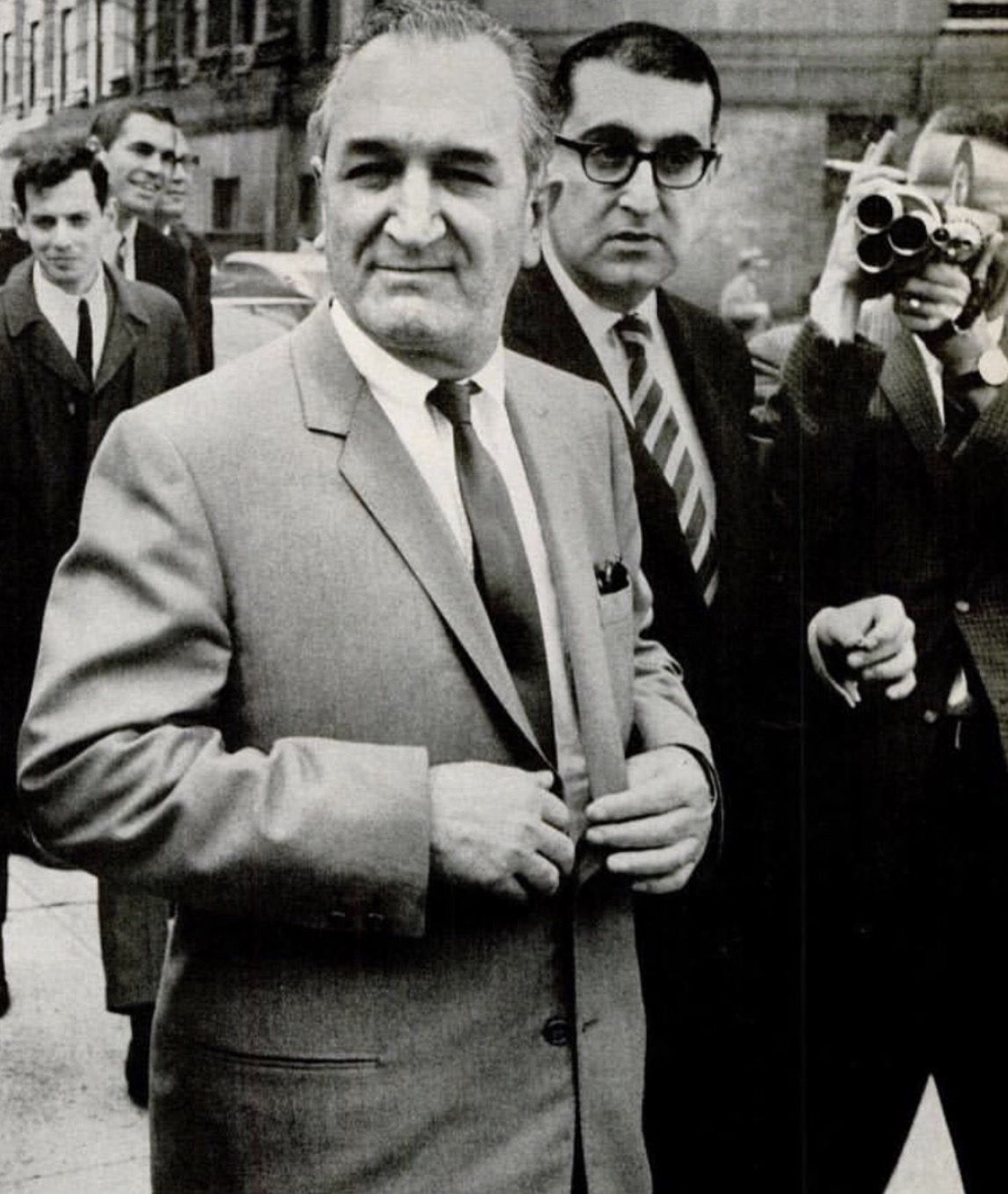 “I’ll put them on the sidelines for now,”
he said. “Let’s focus in on the Mafia for the
time being, because they, of course, had the
biggest imprint on American crime during
Prohibition and afterwards. Most of the guys I
investigated in New York were Mafia, and two of
the biggest—Carlo Gambino and Joe Bonanno (left)—fled
to the U.S. after Mussolini started cracking
down on the Mafia.”
“I’ll put them on the sidelines for now,”
he said. “Let’s focus in on the Mafia for the
time being, because they, of course, had the
biggest imprint on American crime during
Prohibition and afterwards. Most of the guys I
investigated in New York were Mafia, and two of
the biggest—Carlo Gambino and Joe Bonanno (left)—fled
to the U.S. after Mussolini started cracking
down on the Mafia.”
In
the ’20s Bonanno worked for a while as a Capone
stooge, but moved out of Chicago in the ‘30s. During
the war  Gambino stole ration tickets and
sold them on the Black Market. He also invented
the so-called “cement overcoat.”
Gambino stole ration tickets and
sold them on the Black Market. He also invented
the so-called “cement overcoat.”
“Do tell,” said Katie, wincing.
“Yeah,” said David, “he once buried a
hood named Mimi Scialo in the cement floor of a
Brooklyn social club.”
Katie
shook her head, thinking that David’s work had
been far more dangerous than he’d made it out to
be, even if the gangsters steered clear of
killing cops.
“Let’s get back to Il Duce for a moment,”
she said. “I’ve read that Mussolini felt the
Italian crime families to be a direct threat, so
he tried hard to wipe them out, first and
foremost the Mafia.”
She’d
learned that his main weapon was the Minister of
the Interior, Cesare Mori, who got the nickname
the “Iron Prefect.” Mori
was so earnestly honest that before Mussolini
even got into power, Mori (below) was
cracking the heads of the Fascist gangs. It was
said he rounded up 300 Mafia suspects in one
night in Sicily.
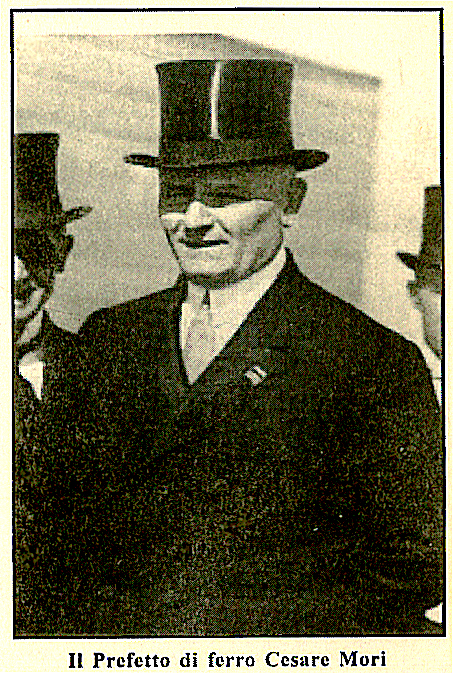 “I like this guy,”
David said.
“I like this guy,”
David said.
“Mussolini knew Mori was his go-to guy,”
said Katie, “giving him carte blanche to do what
he had to do. Supposedly Il Duce told him that
if the current laws didn’t work, he’d write new
ones to allow Mori to get the job done. And Mori
used his power.
He apparently wasn’t against fighting
fire with fire, even if it meant torture and
taking hostages.”
“Ha! Sounds like the Irish cop Sean
Connery played in The
Untouchables.” David
did his best impersonation from the movie: “You
wanna know how to get Capone? They pull a knife,
you pull a gun. He sends one of yours to the
hospital, you send one of his to the morgue.”
“Not a bad impression of Connery,”
laughed Katie.
“So what happened?”
“Mori was very successful, arrested more
than a thousand Mafia members, and Mussolini
announced to the people that the Mafia was
dead.”
“Gee, he got that one wrong,” said David.
“Pure propaganda. But
the Mafia did lie low in the 1930s. So I don’t
think Capone could have worked any kind of deal
with them.
He also probably didn’t trust them. He
hated Sicilians.”
“Okay,” said David, “what about
Mussolini’s need for gold? I
assume he was as desperate as Hitler to get his
hands on as much gold as possible.”
“Absolutely! Mussolini rejoined the gold
standard, which helped plunge Italy into a
recession, so he came up with a program called
‘Gold for the Fatherland,’ which called on all
good Italians to send him their gold.”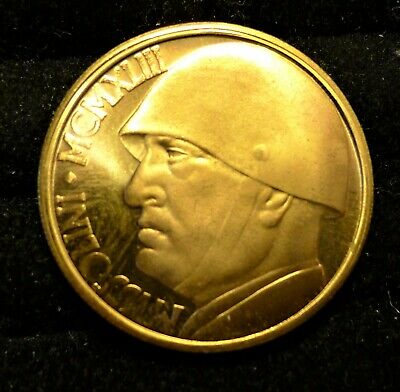
“Jesus,” said David, wide-eyed, “you just
reminded me that my grandmother sent her wedding
ring to Mussolini at that time!”
“Yes, he specifically asked for them to
do so. He told the people his wife had donated
hers. Then he had it all melted down and
distributed to the state banks, which by then
were all under national control. I
guess he collected a lot of gold, because my
History professor said that at the end of the
war the Germans looted $100 million from the
Italian banks.”
“Do you think some of that could have
been Capone’s gold?” asked David.
“Only if Al thought Mussolini would take
care of it for him. I can
imagine it happening: Since Capone never
intended to use the gold himself, he could have
given it to Mussolini, bought a lot of influence
with Il Duce, then told the feds where they
could find it and collect the reward—knowing the
feds would never get the gold back.”
“Beautiful,” said David, “just beautiful. Now
all we have to do is prove it.”
“I was afraid you’d say that.”
© John Mariani, 2015
❖❖❖
THE WINES OF ALSACE
By Geoff Kalish

While
not on most consumers’ lists as “must drink”
wines, Alsatian whites and sparklers provide
many enjoyable, food friendly bottles at very
sensible prices. However, because of low demand,
some retail outlets have stopped carrying these
wines, making finding them not always that
easy—but certainly worth the effort. And for
those interested in at least trying some of
these wines, the following provides a listing
and comments on the best that I have sampled
over the past few months.
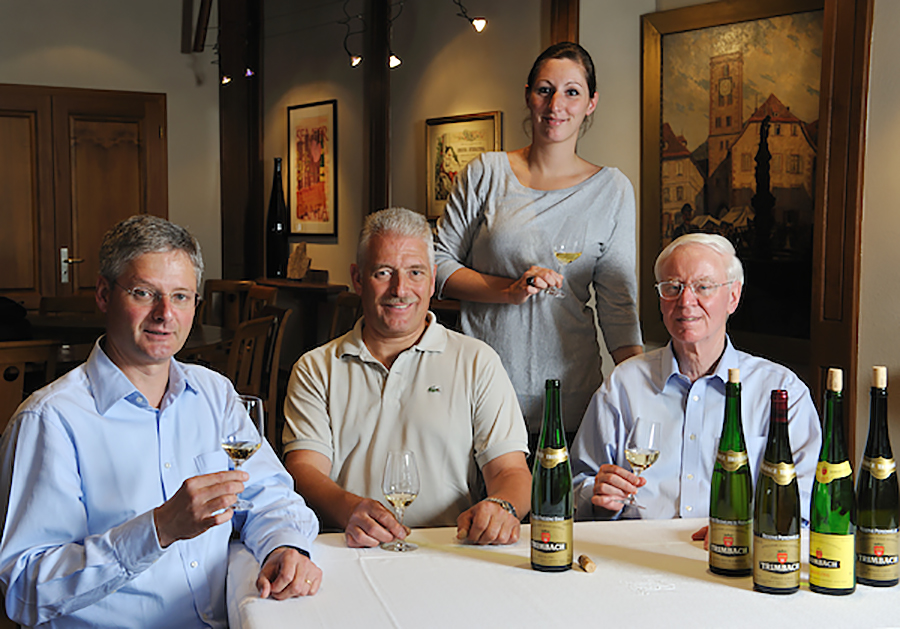 2017 FE
Trimbach Pinot Blanc ($17)—Located in
Ribeauvillé, the Trimbach family has been
producing wine since the 17th century, with this
blend of Pinot Auxerrois and Pinot Blanc fermented
in temperature-controlled stainless steel and
concrete containers. It shows a bouquet resembling
that of a California Chardonnay, with ripe apples
and hints of lemon, and a fresh taste leaning more
to a New Zealand Sauvignon Blanc, with notes of
grapefruit, almonds and spice in its crisp finish.
It mates well with scallops, shrimp and lobster.
2017 FE
Trimbach Pinot Blanc ($17)—Located in
Ribeauvillé, the Trimbach family has been
producing wine since the 17th century, with this
blend of Pinot Auxerrois and Pinot Blanc fermented
in temperature-controlled stainless steel and
concrete containers. It shows a bouquet resembling
that of a California Chardonnay, with ripe apples
and hints of lemon, and a fresh taste leaning more
to a New Zealand Sauvignon Blanc, with notes of
grapefruit, almonds and spice in its crisp finish.
It mates well with scallops, shrimp and lobster.
13th generation,
Hubert Trimbach, nephews Jean and Pierre, and
daughter Anne
2019 FE Trimbach Riesling ($19)—This 100% Riesling exhibits an
aromatic bouquet and fruity taste of ripe pears.
Pineapples and apples with strong notes of lime in
its vibrant finish. Try it with oysters, mussels
or even pork chops.
2016 Domaine Trapet Riquewihr
Riesling ($23)—Made from hand-harvested,
biodynamically farmed grapes, this wine has an
aromatic bouquet and dry taste of apples and pears
with a crisp lemony finish that mates well with
grilled brook trout, arctic char or grilled tuna
steaks.
2016 Wilm
Gewürztraminer Reserve ($16)—Founded in 1896,
Wilm was the first Alsatian wine producer to
export to the US following Prohibition, with its wines said
to be a favorite of Al Capone. Gewürztraminer
grapes (right) show an aromatic bouquet and
taste of ripe apples and lychees with a bit of
spice in its fruity finish. It mates well with
mild, meaty fish like orata and
branzino
as well as shellfish.
the US following Prohibition, with its wines said
to be a favorite of Al Capone. Gewürztraminer
grapes (right) show an aromatic bouquet and
taste of ripe apples and lychees with a bit of
spice in its fruity finish. It mates well with
mild, meaty fish like orata and
branzino
as well as shellfish.
2018 Pierre Sparr
Gewürztraminer ($19)—A pioneer of “estate bottling” in
Alsace, this winery dates back to the 1600s. This
wine has a floral bouquet of honeysuckle and roses
and a light, elegant taste of spice and minerals
with notes of lychee and a crisp finish. It
marries well with grilled trout or chicken.
2016 Meyer-Fonne
“Kaefferkopf” Grand Cru Gewürztraminer ($42)—Made from organic
grapes from 40-year-old vines planted in
clay-limestone soil, this exceptionally floral,
flavorful yet delicate wine, with a bouquet and
dry taste of lychees and honey, marries well with
sushi, as well as duck and turkey.
 By law, Crémant d’Alsace
must be made from hand-harvested grapes pressed as
whole bunches, and. like Champagne, with the
second fermentation (that produces the bubbles)
taking place in the bottle in which the wine will
be sold. As a category, these non-vintage wines
are the second most popular sparklers in France,
after Champagne, and the four discussed below are
perfect for sipping with a range of hors d’oeuvres
like toasts with smoked salmon, smoked trout
spread or olive tapenade as well as with
bruschetta.
By law, Crémant d’Alsace
must be made from hand-harvested grapes pressed as
whole bunches, and. like Champagne, with the
second fermentation (that produces the bubbles)
taking place in the bottle in which the wine will
be sold. As a category, these non-vintage wines
are the second most popular sparklers in France,
after Champagne, and the four discussed below are
perfect for sipping with a range of hors d’oeuvres
like toasts with smoked salmon, smoked trout
spread or olive tapenade as well as with
bruschetta.
Made of 80% Pinot Blanc and 20% Pinot
Auxerrois, the Pierre Sparr
Brut Réserve ($22) showed a bouquet of ripe
apples and mango and notes of ginger in its zesty
finish. The Lucien-Albrecht
Crémant
d’Alsace ($20) is fashioned from a blend of
Pinot Blanc, Pinot Gris and Pinot Auxerrois,
primarily grown around the village of Oschwihr. It
has a delicate bouquet taste of apples, apricots
and melons with a smooth, pleasant finish. The Wilm
($19) and the Dopff &
Iron ($21) brut rosés were both fashioned from 100%
Pinot Noir grapes and exhibit a bouquet and taste
of wild strawberries and raspberries, with the
Wilm showing a bit more acidity in its finish.
❖❖❖
FOOD WRITING 101: SCARING YOUR
READER
FOR NO REASON IS JUST PLAIN DUMB
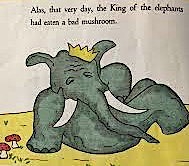
"11 Common Foods That Can Be Toxic. Don’t
worry, they’re still safe to eat!"
When
it comes to food poisoning, we’re aware of the usual
suspects, like chicken
not cooked thoroughly or bad salmon
from a cheap sushi restaurant. Believe it or not,
some foods you never even think twice about contain
naturally occurring toxins that can be potentially
harmful when consumed in large quantities. That
doesn’t mean you need to raid your fridge and pantry
to throw away any of the following foods; it simply
means you should be careful when ingesting and
preparing them.”—By Madeline
Buiano, Daily Meal (9/9/21)
Any of John Mariani's books below may be ordered from amazon.com.
 The Hound in Heaven
(21st Century Lion Books) is a novella, and
for anyone who loves dogs, Christmas, romance,
inspiration, even the supernatural, I hope you'll find
this to be a treasured favorite. The story
concerns how, after a New England teacher, his wife and
their two daughters adopt a stray puppy found in their
barn in northern Maine, their lives seem full of promise.
But when tragedy strikes, their wonderful dog Lazarus and
the spirit of Christmas are the only things that may bring
his master back from the edge of despair.
The Hound in Heaven
(21st Century Lion Books) is a novella, and
for anyone who loves dogs, Christmas, romance,
inspiration, even the supernatural, I hope you'll find
this to be a treasured favorite. The story
concerns how, after a New England teacher, his wife and
their two daughters adopt a stray puppy found in their
barn in northern Maine, their lives seem full of promise.
But when tragedy strikes, their wonderful dog Lazarus and
the spirit of Christmas are the only things that may bring
his master back from the edge of despair. WATCH THE VIDEO!
“What a huge surprise turn this story took! I was completely stunned! I truly enjoyed this book and its message.” – Actress Ali MacGraw
“He had me at Page One. The amount of heart, human insight, soul searching, and deft literary strength that John Mariani pours into this airtight novella is vertigo-inducing. Perhaps ‘wow’ would be the best comment.” – James Dalessandro, author of Bohemian Heart and 1906.
“John Mariani’s Hound in Heaven starts with a well-painted portrayal of an American family, along with the requisite dog. A surprise event flips the action of the novel and captures us for a voyage leading to a hopeful and heart-warming message. A page turning, one sitting read, it’s the perfect antidote for the winter and promotion of holiday celebration.” – Ann Pearlman, author of The Christmas Cookie Club and A Gift for my Sister.
“John Mariani’s concise, achingly beautiful novella pulls a literary rabbit out of a hat – a mash-up of the cosmic and the intimate, the tragic and the heart-warming – a Christmas tale for all ages, and all faiths. Read it to your children, read it to yourself… but read it. Early and often. Highly recommended.” – Jay Bonansinga, New York Times bestselling author of Pinkerton’s War, The Sinking of The Eastland, and The Walking Dead: The Road To Woodbury.
“Amazing things happen when you open your heart to an animal. The Hound in Heaven delivers a powerful story of healing that is forged in the spiritual relationship between a man and his best friend. The book brings a message of hope that can enrich our images of family, love, and loss.” – Dr. Barbara Royal, author of The Royal Treatment.
 |
The Encyclopedia of American Food and Drink by John F. Mariani (Bloomsbury USA, $35) Modesty forbids me to praise my own new book, but let me proudly say that it is an extensive revision of the 4th edition that appeared more than a decade ago, before locavores, molecular cuisine, modernist cuisine, the Food Network and so much more, now included. Word origins have been completely updated, as have per capita consumption and production stats. Most important, for the first time since publication in the 1980s, the book includes more than 100 biographies of Americans who have changed the way we cook, eat and drink -- from Fannie Farmer and Julia Child to Robert Mondavi and Thomas Keller. "This book is amazing! It has entries for everything from `abalone' to `zwieback,' plus more than 500 recipes for classic American dishes and drinks."--Devra First, The Boston Globe. "Much needed in any kitchen library."--Bon Appetit. |
"Eating Italian will never be the same after reading John Mariani's entertaining and savory gastronomical history of the cuisine of Italy and how it won over appetites worldwide. . . . This book is such a tasteful narrative that it will literally make you hungry for Italian food and arouse your appetite for gastronomical history."--Don Oldenburg, USA Today. "Italian
restaurants--some good, some glitzy--far
outnumber their French rivals. Many of
these establishments are zestfully described
in How Italian Food Conquered the World, an
entertaining and fact-filled chronicle by
food-and-wine correspondent John F.
Mariani."--Aram Bakshian Jr., Wall Street
Journal.
"Equal parts
history, sociology, gastronomy, and just
plain fun, How Italian Food Conquered the
World tells the captivating and delicious
story of the (let's face it) everybody's
favorite cuisine with clarity, verve and
more than one surprise."--Colman Andrews,
editorial director of The Daily
Meal.com. "A fantastic and fascinating
read, covering everything from the influence
of Venice's spice trade to the impact of
Italian immigrants in America and the
evolution of alta cucina. This book will
serve as a terrific resource to anyone
interested in the real story of Italian
food."--Mary Ann Esposito, host of PBS-TV's
Ciao
Italia. "John Mariani has written the
definitive history of how Italians won their
way into our hearts, minds, and
stomachs. It's a story of pleasure over
pomp and taste over technique."--Danny Meyer,
owner of NYC restaurants Union Square
Cafe, The Modern, and Maialino.
|
 |
 |
 |
 |
 |
 |
 Everett Potter's Travel Report:
Everett Potter's Travel Report: 
 Eating Las
Vegas JOHN CURTAS has been covering
the Las Vegas food and restaurant scene
since 1995. He is the co-author of EATING LAS
VEGAS – The 50 Essential Restaurants (as
well as the author of the Eating Las
Vegas web site: www.eatinglasvegas.
He can also be seen every Friday morning as
the “resident foodie” for Wake Up With the
Wagners on KSNV TV (NBC) Channel 3 in
Las Vegas.
Eating Las
Vegas JOHN CURTAS has been covering
the Las Vegas food and restaurant scene
since 1995. He is the co-author of EATING LAS
VEGAS – The 50 Essential Restaurants (as
well as the author of the Eating Las
Vegas web site: www.eatinglasvegas.
He can also be seen every Friday morning as
the “resident foodie” for Wake Up With the
Wagners on KSNV TV (NBC) Channel 3 in
Las Vegas.
MARIANI'S VIRTUAL GOURMET
NEWSLETTER is published weekly. Publisher: John Mariani. Editor: Walter Bagley. Contributing Writers: Christopher
Mariani, Misha Mariani, John A. Curtas, Gerry Dawes, Geoff Kalish.
Contributing
Photographer: Galina Dargery. Technical
Advisor: Gerry
McLoughlin.
If you wish to subscribe to this
newsletter, please click here: http://www.johnmariani.com/subscribe/index.html
© copyright John Mariani 2021

